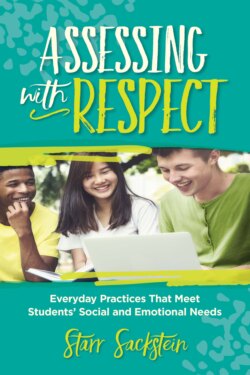Читать книгу Assessing with Respect - Starr Sackstein - Страница 22
На сайте Литреса книга снята с продажи.
Teacher-Family Relationships
ОглавлениеAnother essential relationship that will either enhance or hurt your ability to help students is the one you cultivate with their families. As noted earlier, we all bring more than just ourselves into our learning spaces. Having the most complete picture possible of the learners in front of you is essential—not to mention the fact that you will need to enlist the help of these caregivers as partners in your students' learning.
Understanding how students behave and interact with family members can be extremely helpful in getting some students out of their shells. You'll note that in my high school welcome letter (Figure 1.1), I addressed parents and caregivers as well as students. Because everyone is on the same team, everyone needs to be on the same page about expectations, goals, and contributions to learning.
Create multiple opportunities, beyond those on the school calendar, for family members to speak with you. Remind them that you are always open to their questions, concerns, and involvement, and then take into account what you learn from their insights. Find out families' preferred method of communication—and then make sure to communicate.
Making positive phone calls once a week can be as uplifting for you as it is for your students and their families. The effort promotes caring bonds that can only strengthen future partnerships. Calling only when there is a problem sets up a negative dynamic that doesn't necessarily promote families' willingness to help; it can even make a situation adversarial. Families need to know that you have their kids' best interest at heart, and recognizing and reaching out to share positive experiences helps to do just that.
The extreme circumstance of the COVID-19 pandemic has made positive and communicative relationships with families more important than ever. Being true partners in educating children requires good relationships. You can bring families into the learning space by creating YouTube channels that share learning experiences in addition to the websites or online classrooms facilitated by your district. Families should be privy to what goes on during the school day at any time, not just during a crisis.
Additionally, schools can enlist cultural liaisons, whose important role is explained by Sarah W. Nelson and Patricia L. Guerra (2011) in their newsletter about cultural proficiency:
Educators in schools serving large populations of culturally diverse students often have backgrounds that differ from the students and families they serve. This cultural mismatch can make developing strong school-community relationships a challenge. One strategy for addressing this concern is the use of a cultural liaison. A cultural liaison is someone who has standing within a community culture group and is willing to serve as a link between the community and the school. A cultural liaison helps school personnel better understand the values and norms of the community and helps community members negotiate the structures of the school system. (p. 57)
